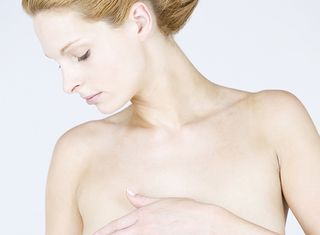What That Lump In Your Breast Might Be?

Breasts change as we age, so lumps may arise and go back down again. The best thing to do is check your breasts regularly so you are aware of what they normally feel like, then you can spot if anything unusual pops up.
There are many things a lump in the breast can be so don't panic and automatically assume it is cancerous. However it's always better to get it checked out with a doctor if anything feels unusual, just to be on the safe side.
Here are five different types of breast lumps that are not cancer.
1) Fibroadenoma
An oval lump that moves when touched and is usually around 1-2cm wide. Fibroadenoma is formed when healthy gland and connective breast tissue clump together. The lump feels like a smooth marble under the skin and is not usually painful. Most of them don't require medical intervention, however in the cases where they grow quite large, they can be surgically removed.
2) Fat necrosis
A hard lump that occurs after heavy bruising such as a bad accident, a fall, or from the impact of a car seatbelt. This lump looks and feels firm, hard and round, it can also lead to skin redness and dimpling. Fat necrosis doesn't need to be treated and usually goes away on its own.
Sign up for the woman&home newsletter
Sign up to our free daily email for the latest royal and entertainment news, interesting opinion, expert advice on styling and beauty trends, and no-nonsense guides to the health and wellness questions you want answered.

3) Cyst
Hormones like estrogen are to blame for cysts, these lumps feel smooth and are easily movable. Cysts are filled with fluid and can be found with an ultrasound. Some cysts disappear completely and others return after a while - some women say ditching caffeine and salt can make them less likely to return. If they are painful they can be deflated by removing the fluid in the cyst with a needle.
4) Fibrocystic changes
These lumps can occur during your menstrual cycle, they are a combination of small cysts and swollen areas of breast tissue. Around 80% of women will experience fibrocystic changes and these usually happen mid-cycle - when estrogen and progesterone levels are higher. The lumps may feel heavy and firm to the touch, but usually the discomfort and cysts will disappear after your cycle.
5) Abscess
An abscess is a collection of pus that forms in the breast and is usually quite painful. Abscesses are caused by bacterial infections, they form under the skin and can be swollen, red and hot to the touch. They are quite common after breastfeeding when bacteria can easily creep into the breast but can also become infected through a cracked nipple or a nipple piercing. Antibiotics can be used to treat the infection and the abscess can be drained with a needle if needed.
-
 32 times the royal children stole the show over the years, from Prince Harry's cheeky poses to huge yawns from Prince Louis
32 times the royal children stole the show over the years, from Prince Harry's cheeky poses to huge yawns from Prince LouisSure, they might be royal, but they're still children at the end of the day...
By Jack Slater Published
-
 32 facts about King Charles's coronation that you might not have known before
32 facts about King Charles's coronation that you might not have known beforeIt was an historic day, but there are probably plenty of details you're not aware of...
By Amy Hunt Published